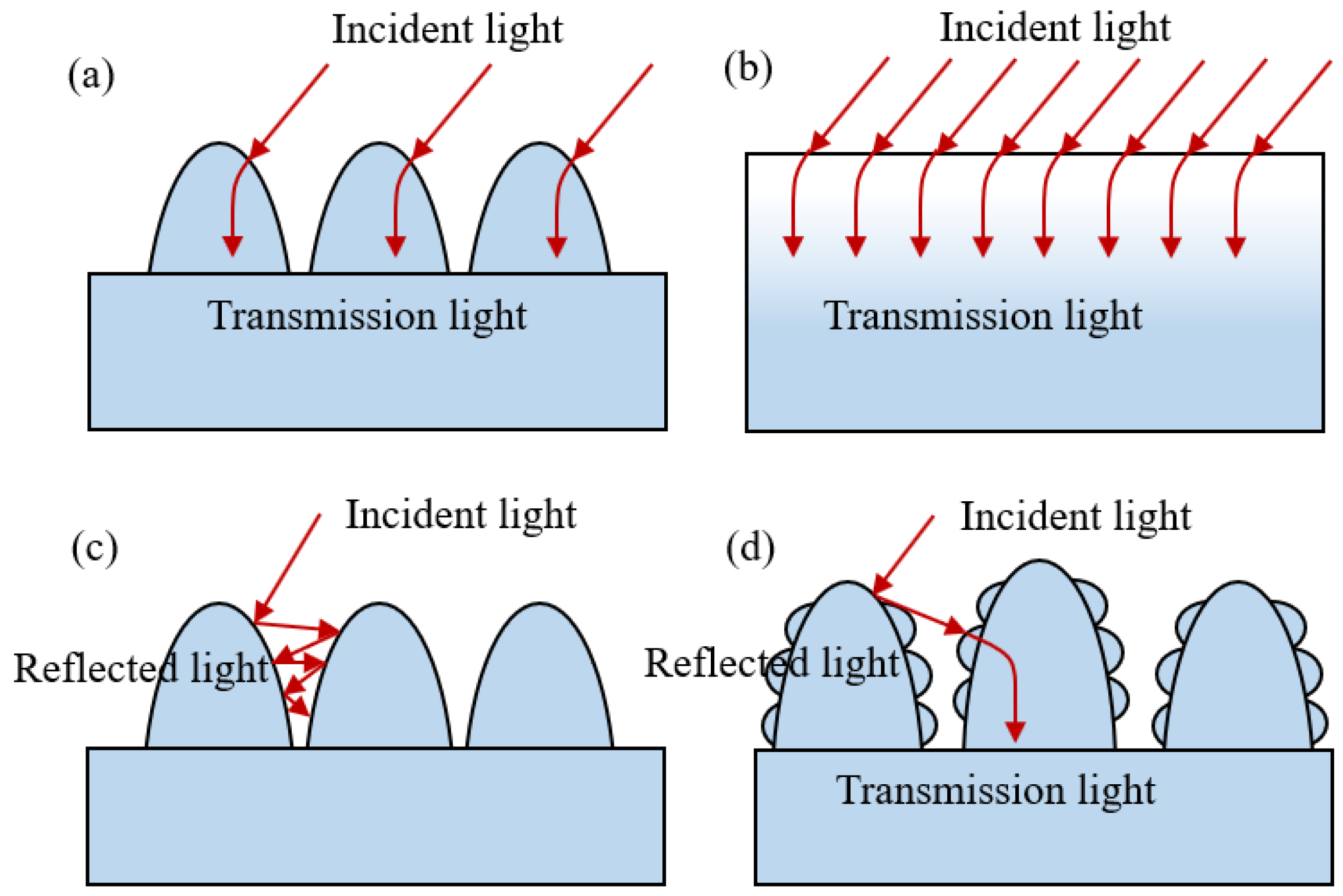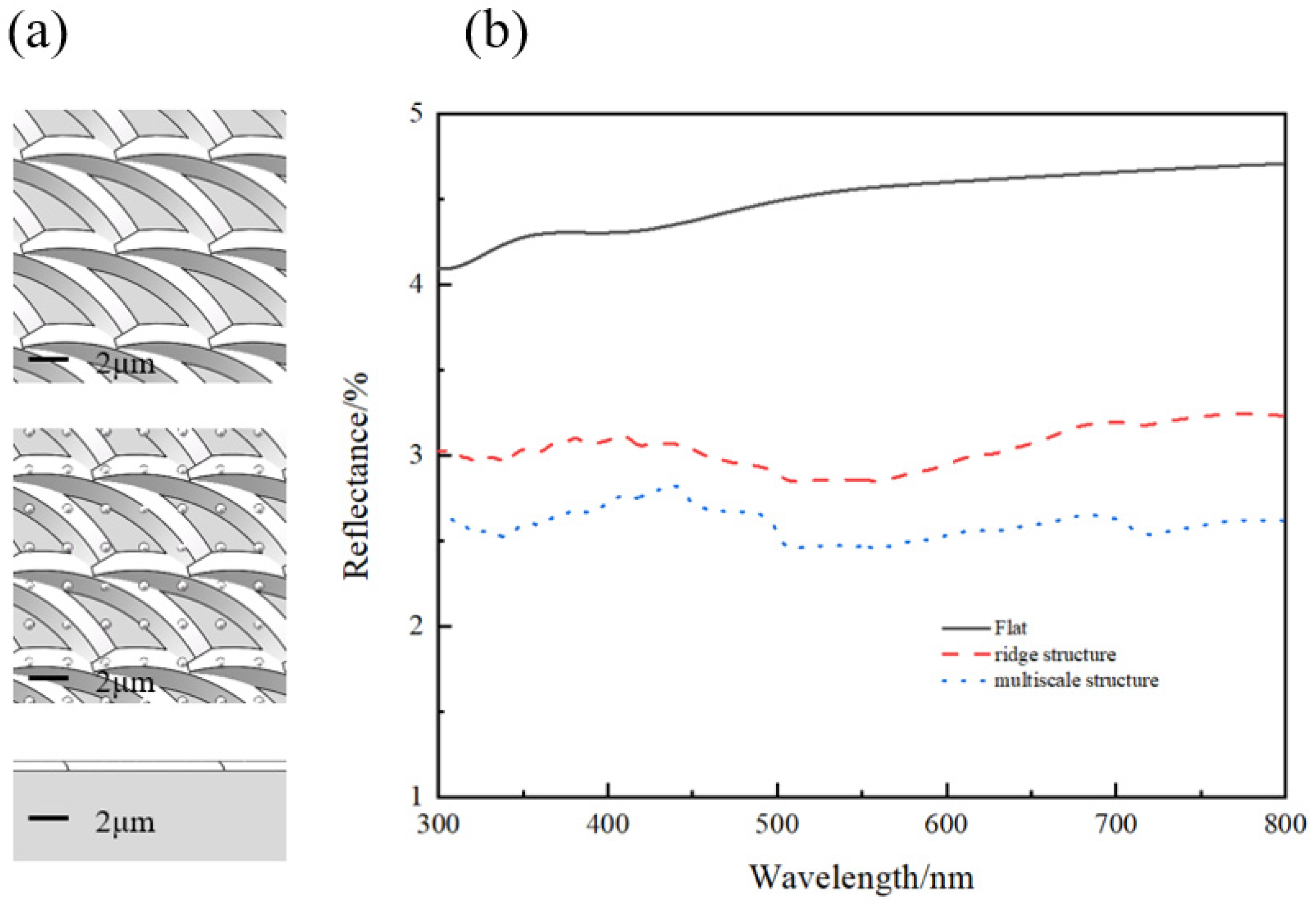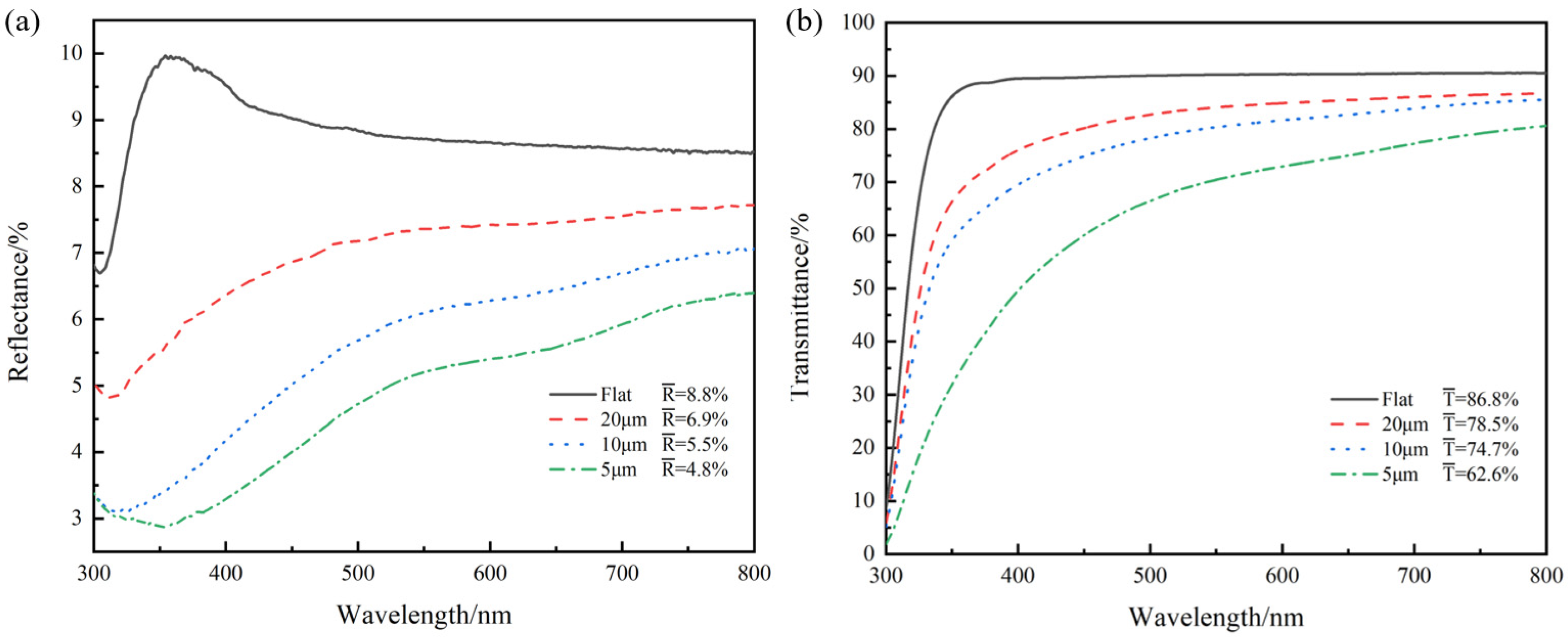General Strategy toward Laser Single-Step Generation of Multiscale Anti-Reflection Structures by Marangoni Effect
Abstract
:1. Introduction
2. Experimental Setup
2.1. Materials and Instruments
2.2. Machining Strategy of the Marangoni Effect
2.3. Characterization
3. Results and Discussion
3.1. Anti-Reflection Mechanism
3.2. Preparation of Multiscale Structure
4. Discussion
5. Conclusions
Author Contributions
Funding
Institutional Review Board Statement
Informed Consent Statement
Data Availability Statement
Conflicts of Interest
References
- Toan, N.V.; Sangu, S.; Saito, T.; Inomata, N.; Ono, T. Fabrication of a SiO2 optical window for controlling light transmission. Microsyst. Technol. 2017, 23, 919–927. [Google Scholar] [CrossRef]
- Sun, G.Y.; Cao, X.; Zhou, H.J.; Bao, S.H.; Jin, P. A novel multifunctional thermochromic structure with skin comfort design for smart window application. Sol. Energy Mater. Sol. Cells 2017, 159, 553–559. [Google Scholar] [CrossRef]
- Choi, J. Novel manufacturing process for anti-glare of LCD cover and development of haze model. J. Mech. Sci. Technol. 2016, 30, 2707–2711. [Google Scholar] [CrossRef]
- Leem, J.W.; Yu, J.S.; Heo, J.; Park, W.K.; Park, J.H.; Cho, W.J.; Kim, D.E. Nanostructured encapsulation coverglasses with wide-angle broadband antireflection and self-cleaning properties for III–V multi-junction solar cell applications. Sol. Energy Mater. Sol. Cells 2014, 120, 555–560. [Google Scholar] [CrossRef]
- Chan, L.W.; Morse, D.E.; Gordon, M.J. Moth eye-inspired anti-reflective surfaces for improved IR optical systems & visible LEDs fabricated with colloidal lithography and etching. Bioinspiration Biomim. 2018, 13, 041001. [Google Scholar]
- Yang, F.Y.; Raeker, B.O.; Nguyen, D.T.; Miller, J.D.; Xiong, Z.; Grbic, A.; Ho, J.S. Antireflection and Wavefront Manipulation with Cascaded Metasurfaces. Phys. Rev. Appl. 2020, 14, 064044. [Google Scholar] [CrossRef]
- Han, Z.W.; Jiao, Z.B.; Niu, S.C.; Ren, L.Q. Ascendant bioinspired antireflective materials: Opportunities and challenges coexist. Prog. Mater. Sci. 2019, 103, 1–68. [Google Scholar] [CrossRef]
- Lou, R.; Zhang, G.D.; Li, G.Y.; Li, X.L.; Liu, Q.; Cheng, G.H. Design and Fabrication of Dual-Scale Broadband Antireflective Structures on Metal Surfaces by Using Nanosecond and Femtosecond Lasers. Micromachines 2020, 11, 20. [Google Scholar] [CrossRef]
- Zhao, L.; Wang, Z.; Zhang, J.; Cao, L.; Li, L.; Yue, Y.; Li, D. Antireflection silicon structures with hydrophobic property fabricated by three-beam laser interference. Appl. Surf. Sci. 2015, 346, 574–579. [Google Scholar] [CrossRef]
- Li, J.R.; Xu, J.K.; Lian, Z.X.; Yu, Z.J.; Yu, H.D. Fabrication of antireflection surfaces with superhydrophobic property for titanium alloy by nanosecond laser irradiation. Opt. Laser Technol. 2020, 126, 106129. [Google Scholar] [CrossRef]
- Neinhuis, C.; Barthlott, W. Characterization and distribution of water-repellent, self-cleaning plant surfaces. Ann. Bot. 1997, 79, 667–677. [Google Scholar] [CrossRef] [Green Version]
- Vukusic, P.; Sambles, J.R. Photonic structures in biology. Nature 2003, 424, 852–855. [Google Scholar] [CrossRef] [PubMed]
- Morikawa, J.; Ryu, M.; Seniutinas, G.; Balcytis, A.; Maximova, K.; Wang, X.; Zamengo, M.; Ivanova, E.P.; Juodkazis, S. Nanostructured Antireflective and Thermoisolative Cicada Wings. Langmuir 2016, 32, 4698–4703. [Google Scholar] [CrossRef]
- Zhao, Y.Z.; Su, Y.L.; Hou, X.Y.; Hong, M.H. Directional sliding of water: Biomimetic snake scale surfaces. Opto-Electron. Adv. 2021, 4, 210008. [Google Scholar] [CrossRef]
- Kuo, W.K.; Hsu, J.J.; Nien, C.K.; Yu, H.H. Moth-Eye-Inspired Biophotonic Surfaces with Antireflective and Hydrophobic Characteristics. ACS Appl. Mater. Interfaces 2016, 8, 32021–32030. [Google Scholar] [CrossRef] [PubMed]
- Papadopoulos, A.; Skoulas, E.; Mimidis, A.; Perrakis, G.; Kenanakis, G.; Tsibidis, G.D.; Stratakis, E. Biomimetic Omnidirectional Antireflective Glass via Direct Ultrafast Laser Nanostructuring. Adv. Mater. 2019, 31, 1901123. [Google Scholar] [CrossRef] [PubMed]
- Sun, J.; Wang, X.; Wu, J.; Jiang, C.; Shen, J.; Cooper, M.A.; Zheng, X.; Liu, Y.; Yang, Z.; Wu, D. Biomimetic Moth-eye Nanofabrication: Enhanced Antireflection with Superior Self-cleaning Characteristic. Sci. Rep. 2018, 8, 5438. [Google Scholar] [CrossRef]
- van de Groep, J.; Spinelli, P.; Polman, A. Single-Step Soft-Imprinted Large-Area Nanopatterned Antireflection Coating. Nano Lett. 2015, 15, 4223–4228. [Google Scholar] [CrossRef]
- Petersen, C.R.; Lotz, M.B.; Markos, C.; Woyessa, G.; Furniss, D.; Seddon, A.B.; Taboryski, R.J.; Bang, O. Thermo-mechanical dynamics of nanoimprinting anti-reflective structures onto small-core mid-IR chalcogenide fibers Invited. Chin. Opt. Lett. 2021, 19, 030603. [Google Scholar] [CrossRef]
- Kanamori, Y.; Sasaki, M.; Hane, K. Broadband antireflection gratings fabricated upon silicon substrates. Opt. Lett. 1999, 24, 1422–1424. [Google Scholar] [CrossRef]
- Wang, X.X.; Pang, Z.Y.; Tong, H.; Wu, X.X.; Bai, X.L.; Yang, H.; Wen, X.L.; Qi, Y.P. Theoretical investigation of subwavelength structure fabrication based on multi-exposure surface plasmon interference lithography. Results Phys. 2019, 12, 732–737. [Google Scholar] [CrossRef]
- Zhu, X.L.; Engelberg, J.; Remennik, S.; Zhou, B.B.; Pedersen, J.N.; Jepsen, P.U.; Levy, U.; Kristensen, A. Resonant Laser Printing of Optical Metasurfaces. Nano Lett. 2022, 22, 2786–2792. [Google Scholar] [CrossRef]
- Zhu, X.L.; Yan, W.; Levy, U.; Mortensen, N.A.; Kristensen, A. Resonant laser printing of structural colors on high-index dielectric metasurfaces. Sci. Adv. 2017, 2, e1602487. [Google Scholar] [CrossRef] [PubMed]
- Xu, J.; Li, X.; Zhong, Y.; Qi, J.; Wang, Z.; Chai, Z.; Li, W.; Jing, C.; Cheng, Y. Glass-Channel Molding Assisted 3D Printing of Metallic Microstructures Enabled by Femtosecond Laser Internal Processing and Microfluidic Electroless Plating. Adv. Mater. Technol. 2018, 3, 1800372. [Google Scholar] [CrossRef]
- Chen, L.; Cao, K.Q.; Li, Y.L.; Liu, J.K.; Zhang, S.; Feng, D.H.; Sun, Z.R.; Jia, T.Q. Large-area straight, regular periodic surface structures produced on fused silica by the interference of two femtosecond laser beams through cylindrical lens. Opto-Electron. Adv. 2021, 4, 200036. [Google Scholar]
- Zhang, D.S.; Li, X.Z.; Fu, Y.; Yao, Q.H.; Li, Z.G.; Sugioka, K. Liquid vortexes and flows induced by femtosecond laser ablation in liquid governing formation of circular and crisscross LIPSS. Opto-Electron. Adv. 2022, 5, 210066. [Google Scholar] [CrossRef]
- Dostovalov, A.; Bronnikov, K.; Korolkov, V.; Babin, S.; Mitsai, E.; Mironenko, A.; Tutov, M.; Zhang, D.; Sugioka, K.; Maksimovic, J.; et al. Hierarchical anti-reflective laser-induced periodic surface structures (LIPSSs) on amorphous Si films for sensing applications. Nanoscale 2020, 12, 13431–13441. [Google Scholar] [CrossRef] [PubMed]
- Duan, M.; Wu, J.; Zhang, Y.; Zhang, N.; Chen, J.; Lei, Z.; Yi, Z.; Ye, X. Ultra-Low-Reflective, Self-Cleaning Surface by Fabrication Dual-Scale Hierarchical Optical Structures on Silicon. Coatings 2021, 11, 1541. [Google Scholar] [CrossRef]
- Du, M.; Sun, Q.; Jiao, W.; Shen, L.; Chen, X.; Xiao, J.; Xu, J. Fabrication of Antireflection Micro/Nanostructures on the Surface of Aluminum Alloy by Femtosecond Laser. Micromachines 2021, 12, 1406. [Google Scholar] [CrossRef]
- Hunig, R.; Mertens, A.; Stephan, M.; Schulz, A.; Richter, B.; Hetterich, M.; Powalla, M.; Lemmer, U.; Colsmann, A.; Gomard, G. Flower Power: Exploiting Plants' Epidermal Structures for Enhanced Light Harvesting in Thin-Film Solar Cells. Adv. Opt. Mater. 2016, 4, 1487–1493. [Google Scholar] [CrossRef]
- Han, Z.; Mu, Z.; Li, B.; Niu, S.; Zhang, J.; Ren, L. A High-Transmission, Multiple Antireflective Surface Inspired from Bilayer 3D Ultrafine Hierarchical Structures in Butterfly Wing Scales. Small 2016, 12, 713–720. [Google Scholar] [PubMed]
- Leem, J.W.; Dudem, B.; Yu, J.S. Biomimetic nano/micro double-textured silicon with outstanding antireflective and superhydrophilic surfaces for high optical performance. RSC Adv. 2017, 7, 33757–33763. [Google Scholar]
- Ou, H.F.; Lin, Y.K.; Hsueh, C.H. Structural and Optical Properties of Textured Silicon Substrates by Three-Step Chemical Etching. Langmuir 2021, 37, 9622–9629. [Google Scholar] [PubMed]
- Kudryashov, S.; Danilov, P.; Rupasov, A.; Khonina, S.; Nalimov, A.; Ionin, A.; Krasin, G.; Kovalev, M. Energy deposition parameters revealed in the transition from 3D to 1D femtosecond laser ablation of fluorite at high-NA focusing. Opt. Mater. Express 2020, 10, 3291–3305. [Google Scholar]
- Han, J.H.; Li, Y.G.; Zhang, Q.H.; Fu, Y.Q.; Fan, W.X.; Feng, G.Y.; Yang, L.M.; Xie, X.D.; Zhu, Q.H.; Zhou, S.H. Phase explosion induced by high-repetition rate pulsed laser. Appl. Surf. Sci. 2010, 256, 6649–6654. [Google Scholar]
- Kim, K.K.; Ha, I.; Won, P.; Seo, D.G.; Cho, K.J.; Ko, S.H. Transparent wearable three-dimensional touch by self-generated multiscale structure. Nat. Commun. 2019, 10, 2582. [Google Scholar]
- Rudenko, A.; Colombier, J.P.; Hohm, S.; Rosenfeld, A.; Kruger, J.; Bonse, J.; Itina, T.E. Spontaneous periodic ordering on the surface and in the bulk of dielectrics irradiated by ultrafast laser: A shared electromagnetic origin. Sci. Rep. 2017, 7, 12306. [Google Scholar]
- Taylor, R.; Hnatovsky, C.; Simova, E. Applications of femtosecond laser induced self-organized planar nanocracks inside fused silica glass. Laser Photonics Rev. 2008, 2, 26–46. [Google Scholar]
- Yu, G.Q.; Gu, D.D.; Dai, D.H.; Xia, M.J.; Ma, C.L.; Shi, Q.M. On the role of processing parameters in thermal behavior, surface morphology and accuracy during laser 3D printing of aluminum alloy. J. Phys. D-Appl. Phys. 2016, 49, 135501. [Google Scholar]
- Ermak, O.; Zenou, M.; Toker, G.B.; Ankri, J.; Shacham-Diamand, Y.; Kotler, Z. Rapid laser sintering of metal nanoparticles inks. Nanotechnology 2016, 27, 385201. [Google Scholar]









| Scanning Distances | Ra/(μm) | Rz/(μm) | Sa/(μm) | Sz/(μm) |
|---|---|---|---|---|
| 20 μm | 0.0727 | 0.3785 | 0.0754 | 0.6370 |
| 10 μm | 0.1176 | 0.6343 | 0.1099 | 0.8514 |
| 5 μm | 0.0756 | 0.5458 | 0.0856 | 0.910 |
Publisher’s Note: MDPI stays neutral with regard to jurisdictional claims in published maps and institutional affiliations. |
© 2022 by the authors. Licensee MDPI, Basel, Switzerland. This article is an open access article distributed under the terms and conditions of the Creative Commons Attribution (CC BY) license (https://creativecommons.org/licenses/by/4.0/).
Share and Cite
Yin, J.; Yan, H.; Dunzhu, G.; Wang, R.; Cao, S.; Zhou, R.; Li, Y. General Strategy toward Laser Single-Step Generation of Multiscale Anti-Reflection Structures by Marangoni Effect. Micromachines 2022, 13, 1491. https://doi.org/10.3390/mi13091491
Yin J, Yan H, Dunzhu G, Wang R, Cao S, Zhou R, Li Y. General Strategy toward Laser Single-Step Generation of Multiscale Anti-Reflection Structures by Marangoni Effect. Micromachines. 2022; 13(9):1491. https://doi.org/10.3390/mi13091491
Chicago/Turabian StyleYin, Jingbo, Huangping Yan, Gesang Dunzhu, Rui Wang, Shengzhu Cao, Rui Zhou, and Yuanzhe Li. 2022. "General Strategy toward Laser Single-Step Generation of Multiscale Anti-Reflection Structures by Marangoni Effect" Micromachines 13, no. 9: 1491. https://doi.org/10.3390/mi13091491
APA StyleYin, J., Yan, H., Dunzhu, G., Wang, R., Cao, S., Zhou, R., & Li, Y. (2022). General Strategy toward Laser Single-Step Generation of Multiscale Anti-Reflection Structures by Marangoni Effect. Micromachines, 13(9), 1491. https://doi.org/10.3390/mi13091491






